In my previous post you had the possibility to follow on how to configure the backup jobs through the VDP. In this article you'll see the restore operations and also some options on further configuration this backup appliance through your browser, which might be usefull in the future.
There are all the configuration options (which can be changed), Network configuration, change the password of the VDP, change timezone and also change the configuration relative to vCenter (you can re-connect to another vCenter if you like). You'll be able to find also there options for further upgrading the appliance – when an upgrade will be released, but I'll mention few other options at the end of the article.
Nice option on rolling back to latest known valid state of the backup repository – this is in case something goes wrong and your backup repository is in invalid state. vSphere Data Protection is a software appliance being sold as a part of the vSphere Essentials Plus Package. The actual performance will depends of the performance of the underlaying hardware (CPU and storage). You might obtain a better performance with a backup software which gets installed on a dedicated physical server. Usually those solution can also leverage a lan free backup option which speeds up the transfer of the data being backed up.
If you got here and configured the backup job as I showed you, you should have at least one valid restore point. You should see a screen like on the image below. You'll get there by going to vSphere Data Protection > Restore TAB.
By clicking the next button you'll see the choice to select where to restore. If you don't want to restore to the original location, simply uncheck the case and choose the location where you want to restore. You might want to specify another name for the VM, than the default one, which has the NAME_and_DATE format, where the date is obviously the date of the restore. Click finish to initiate the restore operation.
Strangely enough, I can't find any progress window from within the new vSphere Web Client (the Recent Task windows doesn't show anything concerning VDP….), so the only possiblity I have is to follow the restore process through the old good classic Windows client….
Well that's about that…
Here is a few screenshot from the re-configuration screen after the vSphere Data Protection (VDP) appliance has been setup, and so you have the options to change some settings as I mentionned earlier. You can restart the appliance's services if necessary.
To get to this config screen, you must point your browser to this url: https://<IP_of_your_VDP_appliance>:8543/vdp-configure/
I repeat here the default root password (just in case) : changeme
And here is the screen which can be usefull when you need to roll-back to the consistent state (if that one day happens). One never know…
The upgrade of the appliance has to follow some guiedlines. It's necessary to make snapshot before the launch of the upgrade process. The snapshot needs to be deleted after successfull upgrade. BUT, to be able to snapshot the VDP, it's necessary to reconfigure the virtual disks of the appliance. Because the disks are in Indpendent – nonpersistend mode. Just to be able to proceed with the snapshot.
At installation time, the virtual disks used by the vSphere Data Protection appliance are set to be “Independent – Persistent.” However, in order to take a snapshot, the disks will have to be temporarily changed to “Dependent.”
This is about it. You know how to architect, install and configure the VDP appliance, you know how to configure a backup job, and you know how to restore. What else?
vSphere Data Protection and File level Restore
The file level restore operations has to be done from within the VM where you have lost the files. You can RDP to that VM or use a vSphere client (or web client).
Then launch a web browser to this page: https://<IP_of_your_VDP_appliance>:8543/flr
Note: You'll need a Flash player to be installed in the web browser.
You login to the VDP restore client with valid administrative credentials. If you're an enterprise admin and want to browse all the VMs that has been backed up and so have the possibility to browse all the recovery points for any virtual machine backed up, then you'll use what they call Basic Login (login with administrative credentials of the vCenter server).
OR, you can restrict to the recovery of single files only to the VM where the files needs to be restored – the login used is the local login of that VM. In this case, only this VM is listed with the restore points. The other VMs are hidden.
You'll be able to see the options to recover individual files.
Please note that there are some limitations on the FLR, in fact File Level Recovery does not support some virtual disk configurations. Here are those limitations – Unformatted disks, Dynamic disks (Windows) / Multi-Drive Partitions (that is, any partition which is composed of 2 or more virtual disks), GUID Partition Table (GPT) disks, ext4 filesystems, FAT16 filesystems, FAT32 filesystems, Extended partitions, Encrypted partitions, Compressed partitions.
And….. you cannot restore more than 5000 files or folders.
And on the next screen, you have the possibility to restore file from within the VM.
And this wrap-up our little serie on vSphere Data Protection (VDP) backup software included with vSphere Essentials Plus and above VMware vSphere editions. I hope that you enjoyed the ride… -:)
Previous articles.
- Part 1: vSphere Data Protection (VDP) – install, configure, manage
- Part 2: vSphere Data Protection (VDP) – backup and master
- Part 3: This article…
- Possibly needed: How-to reset root password in VDP
- Upgrade 5.0 > 5.1.x: How-to Upgrade VDP – Upgrading vSphere Data protection with the Upgrade ISO
- Might help:VMware VDP Logs – locate and troubleshoot (+ divers tips)
- News: VMware vSphere Data protection (VDP) Advanced Version
- How to migrate backups from VDR to VDP


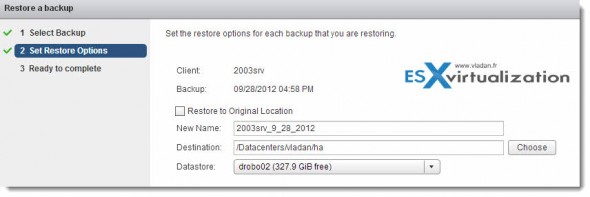

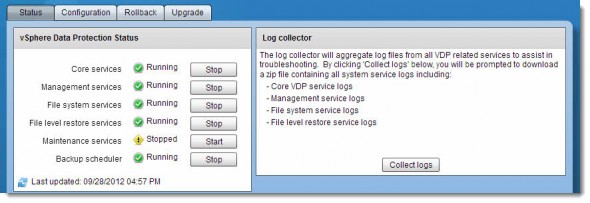
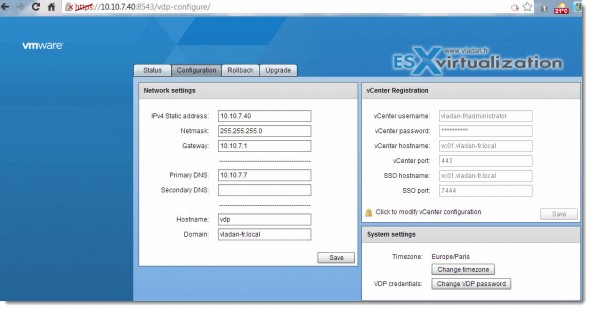

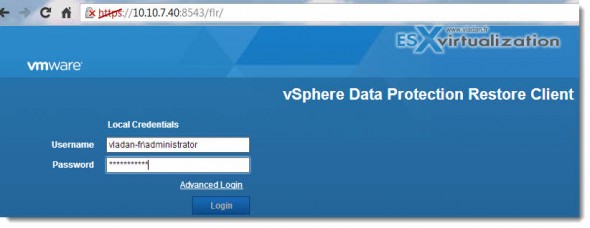
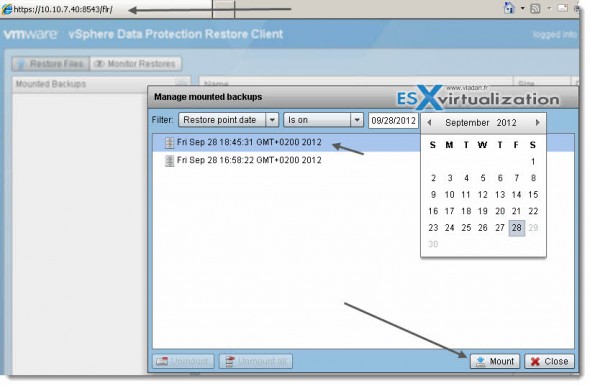
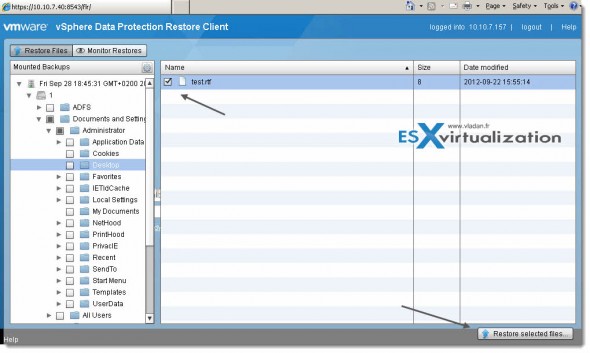
Hi – Really great article series. Helped me very much! One question, suppose you have the backup files (vmdks) on a safe place but have to reinstall the VDP appliance because of a disaster etc. After reinstall VDP, how can you import your old backups into the system or even recover a VM from the old vmdk files?
If you have VMDKs backed up elsewhere, then the easiest is to upload the VMDK disk files directly to the datastore and Add the VM to your vSphere infrastructure….
VDP stores the data in the deduplicated datastore, (like VDR) which is a database. The files aren’t accessible via datastore browser or so… The reinstall of VDP? Very Good question. Any EMC or VMware folks has got the answer? Thanks for stepping in -:).
In my scenario Im using a external QNAP NAS station as backup target, just to get backup files off the regular datastores. I have mounted a NFS share fron QNAP NAS into vSphere, and installed the 0,5 TB VDP appliance on the share. This works nice. But as my question I could not find a way to recover a VM that are backed up and stored inside the appliance vmdks, if the VDP installation is broken.
I see… VDR had the possibility to keep the DB separately from the appliance’s OS. I’m not sure about VDP, since when you install it, all the VMDK are deployed (SYS + Data disks) at the same time.
Try VMware communities, or VMware support. But you can e-mail me the solution if you recovered… -:).
See Chapter #7 “vSphere Data Protection Disaster Recovery” of DP Admin manual.
http://pubs.vmware.com/vsphere-51/topic/com.vmware.ICbase/PDF/vmware-data-protection-administration-guide-51.pdf
Cesare,
thanks for pointing out the manual, but a part of the roll back capability and a real backup of the VDP appliance, there is nothing new there. Certainly the roll back capability will help in most cases. Backup of whole VDP can be challenging….
Vladan, I noticed the section just prior to file-level restore mentions “…Indpendent – nonpersistend mode…”
Should that actually be edited to “Independent – persistent” as the excerpt you include just below states?